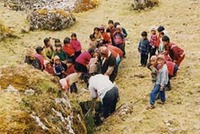For many poor countries, tourism is a crucial source of revenue, presenting hope of a better future. Thus every effort is made to provide the tourists with whatever it is they might want. At least in the case of India, it is not only the fascinating culture, climate, exotic food and locations that draw tourists, but also the cheap cannabis. Those visiting the mountain villages of Thailand often want to try opium. For some tourists in Peru and Bolivia, the inexpensive or high quality cocaine may be an additional incentive to their visit.
The so-called drug tourists can sometimes be responsible for weakening the local people’s opportunities to live according to their traditions. What on the tourist’s part may seem as an innocent sampling of the local produce, may in fact have far-reaching consequences: when drugs are available to tourists, they are also more easily available to the locals. These people, however, are not entitled to the same kind of education on drugs, health services, nor possibilities for rehab that the mostly Western drug users can take for granted on their home turf.
The number of drug addicts in the developing countries is increasing. For instance, during the war in Afghanistan, the number of addicts in Pakistan and other neighboring countries multiplied. In 1998, as much as 58% of the Afghan opium was consumed in the neighboring region.
The US promoted the eradication of opium crops in Thailand in the 1970’s. As a result, opium cultivation moved to Burma and Laos, from where the drug is smuggled to the tourists visiting the mountain regions of Thailand.
In these countries, the opium or heroin addicts are mostly men. Thus the women are left to shoulder the responsibility for the families’ survival. In some cases, both husband and wife are addicts, leaving their children to fend for themselves. Children are known to have become addicts too since they are sometimes given heroin or opium to keep them quiet.
Unlucky travelers may get caught and face draconian prison sentences in local correctional facilities. Even though drug use may seem fairly commonplace and risk-free, every now and then some tourists are nailed to prove to other countries that drug traffic is being seriously fought against.
